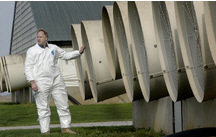



Purdue Begins National Study Of Air Quality At Animal Feeding Operations
PERDUE - Research has officially begun in the largest study ever conducted to measure levels of various gases and airborne pollutants emitted from poultry, dairy and swine facilities across the nation. |
| Al Heber, a Purdue professor of agricultural and biological engineering, inspects a ventilation fan |
Led by Purdue University, the 2.5-year, $14.6 million study will measure levels of hydrogen sulfide, particulate matter and ammonia, among other chemicals, released from livestock facilities. Measurements have begun in locations throughout the country and by midsummer will be under way at all 20 study sites in eight states.
"This study will give us a wealth of much-needed scientific information about livestock-generated air pollution," said Al Heber, the Purdue professor of agricultural and biological engineering who leads the study. "There has never been a study this comprehensive or long-term."
The "National Air Emission Monitoring Study," conducted under the advisement of the U.S. Environmental Protection Agency, will record two continuous years of emission data at concentrated animal feeding operations. These comprise barns and manure storage units like lagoons.
Using advanced measurement tools and methods, this study will fill gaps in EPA's database, Heber said, since little quantitative research has been done on these emissions.
Researchers also will measure emissions from open-air sources like dairy corrals and manure basins and lagoons. Specialized sensors, including lasers and reflectors, will measure levels of hydrogen sulfide and ammonia released.
"This data will help us be able to estimate the quantity of emissions given a farm's activities and number of animals," said Richard Grant, a professor of agronomy and a principal investigator in the study. He said the study would help develop an "emissions-estimating methodology."
In addition to the large amount of data that will be gathered, Heber said the study will establish infrastructure that should later allow researchers to test different abatement strategies to improve downwind air quality.
"For example, if we put hogs on certain diets, we can significantly reduce ammonia emissions," Heber said. "These experiments are needed to develop real solutions in the field."
Other studies have shown that levels of emissions vary by temperature and time of day, factors that can be considered in developing better air-emission controls, Heber said. Many of the producers whose farms are being monitored in the study have indicated receptiveness to follow-up studies on such mitigation strategies, he said.
Two other principal investigators from Purdue include Teng Lim and Jiqin Ni, and Bill Bogan is the study's operations manager.
Purdue will collaborate with 11 researchers from seven different universities in the study. These include Frank Mitloehner and Ruihong Zhang from University of California-Davis; Curt Gooch from Cornell University; Steve Hoff, Jacek Koziel and Jay Harmon from Iowa State University; Larry Jacobson from University of Minnesota; Wayne Robarge and Lingjuan Wang from North Carolina State University; Ken Casey from Texas A&M University's Agricultural Experiment Station; and Pius Ndegwa from Washington State University-Pullman.
This study is funded by the Agricultural Air Research Council, a non-profit organization that receives its funds from livestock industry groups, and will be overseen by the EPA Office of Air Quality Planning and Standards.











